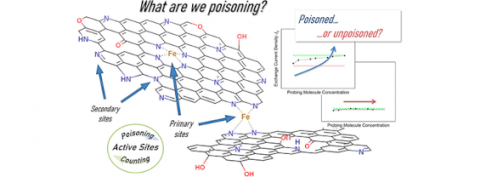Exchange Current Density as an Effective Descriptor of Poisoning of Active Sites in Platinum Group Metal-Free Electrocatalysts for Oxygen Reduction Reaction

In the field of energy conversion devices operating under hydrogen and oxygen like fuel cells, the oxygen reduction reaction (ORR) is of primary importance for the future energy transition. However, ORR necessarily requires an electrocatalyst to be exploited. At the state of the art, platinum group metal-free (PGM-free) electrocatalysts based on carbonaceous nanostructures, heteroatoms, and coordinated transition metals are the most promising alternative to carbon-supported Pt nanoparticles (Pt/C), which are more expensive and more performing, but highly prone to deactivation in contaminated working environments.
The comparison of the two materials is at the level of fine-tuning requiring specific activity descriptors, namely turnover frequency (TOF) and site density (SD), to understand how to improve the performance of PGM-free over Pt/C. Regarding SD, specific probing molecules that bind with the active sites are required to evaluate the number of active sites of PGM-free electrocatalysts. However, PGM-free sites do not possess a single kind of active site like Pt/C, but rather a multitude of primary (metal-containing) and secondary (metal-free) sites arising from the pyrolysis synthesis process, eventually complicating SD evaluation. The work done by Valerio bridges electrochemistry with X-ray photoelectron spectroscopy (XPS) to establish a relationship between performance and surface chemistry.
The results identified a method for evaluating the direct interaction (through chemisorption) of probing molecules over the PGM-free primary and secondary sites.
The discrimination of such interactions is of paramount importance in an effective evaluation of SD, leading to an improved understanding of the nature of active sites. In addition, upon identification of the interaction phenomenon, it will be possible to choose contaminants capable of selective interaction with the active sites of interest, boosting SD evaluation.
Authors:
V.C.A. Ficca, E. Placidi
Link:
ACS Catalysis
